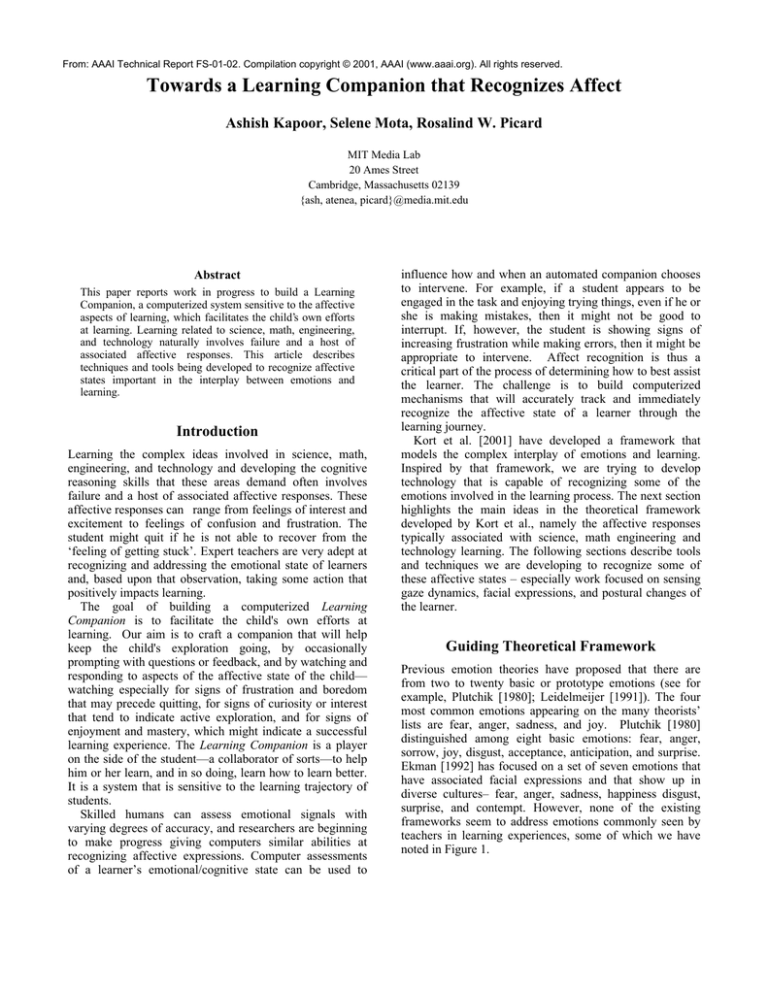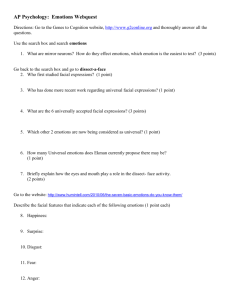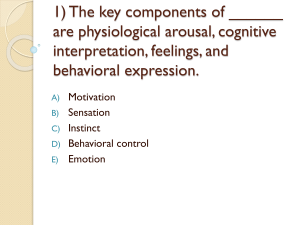
From: AAAI Technical Report FS-01-02. Compilation copyright © 2001, AAAI (www.aaai.org). All rights reserved.
Towards a Learning Companion that Recognizes Affect
Ashish Kapoor, Selene Mota, Rosalind W. Picard
MIT Media Lab
20 Ames Street
Cambridge, Massachusetts 02139
{ash, atenea, picard}@media.mit.edu
Abstract
This paper reports work in progress to build a Learning
Companion, a computerized system sensitive to the affective
aspects of learning, which facilitates the child’s own efforts
at learning. Learning related to science, math, engineering,
and technology naturally involves failure and a host of
associated affective responses. This article describes
techniques and tools being developed to recognize affective
states important in the interplay between emotions and
learning.
Introduction
Learning the complex ideas involved in science, math,
engineering, and technology and developing the cognitive
reasoning skills that these areas demand often involves
failure and a host of associated affective responses. These
affective responses can range from feelings of interest and
excitement to feelings of confusion and frustration. The
student might quit if he is not able to recover from the
‘feeling of getting stuck’. Expert teachers are very adept at
recognizing and addressing the emotional state of learners
and, based upon that observation, taking some action that
positively impacts learning.
The goal of building a computerized Learning
Companion is to facilitate the child's own efforts at
learning. Our aim is to craft a companion that will help
keep the child's exploration going, by occasionally
prompting with questions or feedback, and by watching and
responding to aspects of the affective state of the child—
watching especially for signs of frustration and boredom
that may precede quitting, for signs of curiosity or interest
that tend to indicate active exploration, and for signs of
enjoyment and mastery, which might indicate a successful
learning experience. The Learning Companion is a player
on the side of the student—a collaborator of sorts—to help
him or her learn, and in so doing, learn how to learn better.
It is a system that is sensitive to the learning trajectory of
students.
Skilled humans can assess emotional signals with
varying degrees of accuracy, and researchers are beginning
to make progress giving computers similar abilities at
recognizing affective expressions. Computer assessments
of a learner’s emotional/cognitive state can be used to
influence how and when an automated companion chooses
to intervene. For example, if a student appears to be
engaged in the task and enjoying trying things, even if he or
she is making mistakes, then it might not be good to
interrupt. If, however, the student is showing signs of
increasing frustration while making errors, then it might be
appropriate to intervene. Affect recognition is thus a
critical part of the process of determining how to best assist
the learner. The challenge is to build computerized
mechanisms that will accurately track and immediately
recognize the affective state of a learner through the
learning journey.
Kort et al. [2001] have developed a framework that
models the complex interplay of emotions and learning.
Inspired by that framework, we are trying to develop
technology that is capable of recognizing some of the
emotions involved in the learning process. The next section
highlights the main ideas in the theoretical framework
developed by Kort et al., namely the affective responses
typically associated with science, math engineering and
technology learning. The following sections describe tools
and techniques we are developing to recognize some of
these affective states – especially work focused on sensing
gaze dynamics, facial expressions, and postural changes of
the learner.
Guiding Theoretical Framework
Previous emotion theories have proposed that there are
from two to twenty basic or prototype emotions (see for
example, Plutchik [1980]; Leidelmeijer [1991]). The four
most common emotions appearing on the many theorists’
lists are fear, anger, sadness, and joy. Plutchik [1980]
distinguished among eight basic emotions: fear, anger,
sorrow, joy, disgust, acceptance, anticipation, and surprise.
Ekman [1992] has focused on a set of seven emotions that
have associated facial expressions and that show up in
diverse cultures– fear, anger, sadness, happiness disgust,
surprise, and contempt. However, none of the existing
frameworks seem to address emotions commonly seen by
teachers in learning experiences, some of which we have
noted in Figure 1.
Axis
-1. 0
Anxiety-Confidence
Boredom-Fascination
Frustration-Euphoria
Dispirited-Encouraged
Terror-Enchantment
-0. 5
Anxiety
Ennui
Frustration
Dispirited
Terror
Worry
Boredom
Puzzlement
Disappointed
Dread
0
Discomfort
Indifference
Confusion
Dissatisfied
Apprehension
+0. 5
Comfort
Interest
Insight
Satisfied
Calm
Hopeful
Curiosity
Enlightenment
Thrilled
Anticipatory
+1. 0
Confident
Intrigue
Ephipany
Enthusiastic
Excited
Figure 1. – Some emotions relevant to learning (From Kort et al. [2001])
Figure 2 interweaves the emotion axes shown in Figure 1
with the cognitive dynamics of the learning process (Kort
et al. [2001]). The horizontal axis is an Emotion Axis. It
could be one of the specific axes from Figure 1, or it could
symbolize the n-vector of all relevant emotion axes (thus
allowing multi-dimensional combinations of emotions).
The positive valence (more pleasurable) emotions are on
the right; the negative valence (more unpleasant) emotions
are on the left. The vertical axis is the Learning Axis, and
symbolizes the construction of knowledge upward, and the
discarding of misconceptions downward.
Constructive Learning
Disappointment,
Puzzlement,
Confusion
Awe,
Satisfaction,
Curiosity
II
I
Negative
Affect
Frustration,
Discard,
Misconception
Positive
Affect
III
IV
Hopefulness,
Fresh Research
Un Learning
Figure 2. – Model relating phases of learning to
emotions (From Kort et al. [2001]).
A typical learning experience involves a range of
emotions, moving the student around the space as they
learn (Kort et al. [2001]). Typically, movement would
begin in quadrant I and proceed in a counter-clockwise
direction. The student might be curious/fascinated and/or
interested when he begins in quadrant I. He might be
puzzled /disappointed/ confused and/or motivated to reduce
confusion in quadrant II. In either case, the student is in the
top half of the space if his focus is on constructing or
testing knowledge. Movement happens in this space as
learning proceeds. For example, when solving a puzzle in
the software product The Incredible Machine, a student
gets an idea how to implement a solution and then builds its
simulation. When he runs the simulation and it fails, he
sees that his idea has some part that doesn’t work – that
needs to be deconstructed. At this point it is not
uncommon for the student to move down into the lower
half of the diagram (quadrant III) where emotions may be
frustration/ hopelessness/ boredom and the cognitive focus
changes to eliminating some misconception. As he
consolidates his knowledge—what works and what does
not—with awareness of a sense of making progress, he
may move to quadrant IV (hopefulness/ excitement/
confident).
Ideally, the Learning Companion should observe and try
to understand the processes a learner experiences during all
of these quadrants; however, this is currently beyond the
capabilities of the technology. Our research is examining
what aspects of the learner’s affect can be reliably detected,
with emphasis on those aspects that are most likely to be
useful to a learning companion in determining when and
how to intervene. Toward this aim, we are focusing
initially on the sensing of states that may indicate a learner
has drifted or is soon to drift from the task of learning (is
off-goal). The aim of the initial intervention will be to help
the learner return to being on-goal.
Affect Recognition in Learning
A lot of research had been done to develop ways and
methods to infer affective states. Questionnaires have been
used to infer affect from motivational and affective factors
such as “curiosity, interest, tiredness, and boredom. (e.g.,
Matsubara and Nagamashi [1996]; de Vicente and Pain,
[1999]). In a system by Klein et al. [1999], dialogue boxes
with radio buttons were used for querying users about
frustration. Although questionnaires can easily be
administered, they have been criticized for being static and
thus not able to recognize changes in affective states. Del
Soldato [1994] had success in gathering information about
the subject’s affective state via face-to-face dialogue but
studies of spoken assistance on demand (Olson and Wise
[1987]) have revealed a serious flaw in assuming that
young readers are willing and able to ask for help when
they need it.
A more dynamic and objective approach for assessing
changes in a person’s affective state is via assessing sentic
modulation (Picard [1997]), analyzing a person’s emotional
changes via sensors such as cameras, microphones, strain
gauges, special wearable devices, and other. The computer
assesses a constellation of such patterns and relates them to
the user’s affective state. Scheirer et al. [1999] have built
Expression Glasses that discriminate between upward
eyebrow activity indicative of expressions such as interest
and downward eyebrow activity indicative of confusion or
dissatisfaction. Healey [2000] has used physiological
sensors to infer stress levels in drivers, and Picard et al.
[2001] have reported 81% classification accuracy of eight
emotional states of an individual over many days of data,
based on four physiological signals. A survey of a variety
of projects at the MIT Media Lab related to machine
recognition of emotion is available (Picard [2001]).
The problem of automatic affect recognition is a hard
one. Under restrictive assumptions in choosing from among
about six different affective states, accuracy of from 6080% is still state-of-the art in recognizing affect from
speech. A lot of research has been directed at the problem
of recognizing 5-7 classes of emotional expression on
groups of 8-32 people from their Facial Expressions (e.g.,
Yacoob and Davis [1996]; Essa [1997]). Other recent
studies indicate that combining multiple modalities, namely
audio and video, for emotion recognition can give
improved results ([DeSilva et al. [1997]; Huang et al.
[1998]; Chen et al. [1998]). Most of the results are focused
on deliberately expressed emotions posed in front of a
camera (happy /sad /angry etc.), and not on those that arise
in natural situations such as classroom learning.
Other facial expression analysis research has focused not
so much on recognizing a few categories of “emotional
expressions” but on recognizing specific facial actions—
the fundamental muscle movements that comprise Paul
Ekman's Facial Action Coding System, which can be
combined to describe all facial expressions (Ekman,
[1978]). These facial actions are essentially facial
phonemes, which can be assembled to form facial
expressions. Donato et al. [1999] compared several
techniques, which included optical flow, principal
component analysis, independent component analysis, local
feature analysis and Gabor wavelet representation, to
recognize eight single action units and four action unit
combinations using image sequences that were manually
aligned and free of head motions. Yingli Tian et al. [2001]
have developed a system to recognize sixteen action units
and any combination of those using facial feature tracking.
The techniques mentioned above were not aimed at
reliably recognizing all the affective states in learning like
interest/ boredom/ confusion/ excitement. The Learning
Companion aims to sense truly felt emotional and cognitive
aspects of the learning experience in an unobtrusive way.
Cues like posture, gesture, eye gaze, facial expression etc.
help expert teachers to recognize whether the learner is on
task or off task. Rather than identifying exact emotional
state continuously throughout the learning experience we
aim to able to identify the surface level behaviors that
suggest a transition from an on-goal state to off-goal state
or vice versa.
expressions. Rich et al. [1994] have defined symbolic
postures that convey a specific meaning about the actions
of a user sitting in an office which are: interested, bored,
thinking, seated, relaxed, defensive, and confident. Leaning
forward towards a computer screen might be a sign of
attention (on-task) while slumping on the chair or fidgeting
suggests frustration/ boredom (off-task).
The direction of eye gaze is an important signal to assess
the focus of attention of the learner. In an on-task state the
focus of attention is mainly toward the problem the student
is working on, whereas in an off-task state the eye-gaze
might wander off from it. The facial expressions and head
nods are also good indicators of affective and motivational
states. Approving head nods and facial actions like smile
(AU 6+12), tightening of eyelids while concentrating (AU
7), eyes widening (AU 5) and raising of eyebrows (AU
1+2) suggest interest/ surprise/ excitement (on task),
whereas head shakes, lowering of eyebrows (AU 1+4),
nose wrinkling (AU 9) and depressing lower lip corner (AU
15) suggests the state off-task. Similarly appropriately
directed activity on the mouse and keyboard can be a sign
of engagement whereas no activity or sharp repetitive
activities may be a sign of disengagement or irritation.
These surface level behaviors and their mappings are
loosely summarized in table 1. Whether all of these are
important, and are the right ones remains to be evaluated,
and it will no doubt take many investigations. Such a set of
behaviors may be culturally different and will likely vary
with developmental age as well. The point we want to
make is that we are examining a variety of surface level
behaviors related to inferring the affective state of the user,
while he or she is engaged in natural learning situations.
On Task
Off Task
Posture
Leaning Forward,
Sitting Upright
Slumping on the
Chair, fidgeting
Eye-Gaze
Looking towards
the problem
Looking
everywhere else
Facial
Expressions
Eyes
Tightening(AU7),
Widening(AU5),
Raising Eyebrows
(AU 1+2),
Smile(AU6+12)
Lowering
Eyebrow(AU1+4),
Nose
Wrinkling(AU9),
Depressing lower
lip corner(AU15)
Head Nod/
Head Shake
Up-Down Head
Nod
Sideways Head
Shake
Hand
Movement
Typing, clicking
mouse
Hands not on
mouse/keyboard
Surface Level Behaviors to Infer Affect
Affective states in learning (like interest/ boredom/
confusion /excitement) are accompanied by different
patterns of postures, gesture, eye-gaze and facial
Table 1. Surface Level Behaviors
Recognizing Surface Level Behavior
The detection of the surface level behaviors is critical to the
performance of the Learning Companion. We have been
working on mechanisms to sense posture, eye-gaze and
facial expressions in an unobtrusive manner so that they
don’t interfere with the natural learning process.
Facial Features and Gaze Tracking. We have built a
version
of
the
IBM
Blue
Eyes
Camera
(http://www.almaden.ibm.com/cs/blueeyes) that tracks
pupils unobtrusively. The pupil tracking system is shown in
Figure 3. The system has an Infrared (IR) sensitive camera
coupled with two sets of IR LEDs. One set of LEDs is on
the optical axis and produces the red eye effect. The two
sets of LEDs are switched on and off to generate two
interlaced images for a single frame (Haro et al. [2000]).
The image where the on-axis LEDs are on has white
pupils whereas the image where off-axis LEDs are on has
black pupils. These two images are subtracted to get a
difference image,which is used to track the pupils. Figure 4
Image Captured by Camera
De-Interlaced Sampled
Image when On Axis LEDs
are on
De-Interlaced Sampled
Image when Off Axis LEDs
are on
Figure 3. – Camera to track pupils, placed under monitor.
Difference Image
shows a sample image, the de-interlaced images and the
difference image obtained using the system.
The facial action recognition system developed by Yingli
Tian et al. [2001] requires the fitting of templates for facial
features manually in the first frame. We are developing
techniques using the pupil tracking system to automatically
detect facial features like eyes, eyebrows, etc. in real time.
The IR pupil tracking system is quite robust in different
lighting conditions as well and can be used extensively to
normalize the images and to determine the gaze-direction.
We are building a system to detect head-nods and headshakes using the position of pupils in the image. Also the
physiological parameters like pupillary dilation, eye-blink
rate etc. can be extracted to infer information about arousal
and cognitive load.
Despite all these advantages the capability of the system
is limited to the instances where the eyes are visible in the
image. In our preliminary experiments we have observed
that for a person using a computer in a normal manner, at
least one pupil is visible (hence trackable) to the IR system
for over 85 % of the time, whereas both the pupils are
present for over 75% of the time. As the tracking of pupils
depends upon the difference of two frames separated by
Figure 4. – Pupil tracking with the Blue Eyes camera.
th
approximately 1/60 of a second, a very quick movement
by the person or a fast enough temporal source that can
change the image in the odd field from the image in the
even field (for example flicker of monitor) affects the
tracker. Pattern recognition also needs to be added to
disambiguate the pupils from other bright spots that show
up due to IR reflections bouncing off earrings or
eyeglasses.
Recognizing Postures. Different postures are recognized
using a sensor chair that uses an array of force sensitive
resistors and is similar to the Smart Chair used by Tan et
al. (1997). It consists of two 0.10 mm thick sensor sheets,
with an array of 42-by-48 sensing units. Each unit outputs
an 8-bit pressure reading. One of the sheets is placed on the
backrest and one on the seat. The pressure distribution map
(2 of 42x48 points) sensed at a sampling frequency of 50Hz
is used to infer about the posture. The sensor chair is shown
in Figure 5.
Future Directions
We are in the process of further refining the sensors and
algorithms to detect affective cues like posture, gaze
direction, facial expressions etc. The functionality of the
IBM Blue Eyes camera is being extended to real time
tracking of gaze and recognition of FACS (Ekman 1978).
Pattern recognition techniques are being used on the data
gathered by the sensor chair to determine the posture in real
time. Also we are analyzing the data collected by the IBM
Blue Eyes Camera and the sensor chair to verify the
mapping between the surface level behavior and the
affective state. Ultimately our goal is to develop a multimodal system for informing the Learning Companion, so
that it is capable of recognizing in real time whether the
student is off-task, and whether or not its intervention
succeeds in helping the student return to being on-task.
Figure 5. – The Sensor Chair
The real advantage of using this kind of system is that it
supports very fast real time acquisition of data and does not
depend upon the persons, surroundings etc. Furthermore the
ergonomic requirements are minimal. The system can
easily detect postures like whether the person is leaning
forward or backward and whether he is slumped toward his
side. Figure 6. shows some of the associated patterns with
the different postures. It can track the joint positions of the
lower body and detect swinging of feet as well.
Acknowledgments. We are indebted to Nancy Alvarado,
Barry Kort and Rob Reilly for the insightful discussions.
We thank Ted Selker, Surj Patel and Yue Hann Chin for
helping with IBM Blues Eyes setup and Hong Tan for the
help with the sensor chair. This research was supported by
NSF ROLE grant 0087768.
Upper Sheet
Lower Sheet
Sitting
Upright
Leaning
Forward
Slump
Backwards
Figure 6. – Sensor chair patterns associated with postures
Leaning
Sideways
Reengineering Educational Pedagogy-Building a Learning
Companion. In Proceedings of IEEE International
Conference on Advanced Learning Technologies. Madison.
References
Chen, L.S., Huang, T. S., Miyasato, T., and Nakatsu, R.
1998.
Multimodal
Human
Emotion/Expression
Recognition. In Proceedings of the Third International
Conference on Automatic Face and Gesture Recognition.
Nara, Japan.
Del Soldato, T. 1994. Motivation in Tutoring Systems.
Technical Report, CSRP 303, School of Cognitive and
Computing Science, The University of Sussex, UK.
DeSilva, L.C., Miyasato, T., and Nakatsu, R. 1997. Facial
Emotion Recognition using Multi-Modal Information. In
Proceedings of IEEE International Conference on Info.,
Communications and Signal Processing. Singapore.
de Vicente, A. and Pain, H. 1999. Motivation Self-Report
in ITS. In Lajoie, S. P. and Vivet, M. editors, Proceedings
of the Ninth World Conference on Artificial Intelligence in
Education, 651-653. Amsterdam, IOS Press.
Donato, G., Bartlett, M. S., Hager, J. C., Ekman, P. and
Sejnowski, T. J. 1999. Classifying Facial Actions. IEEE
Transactions on Pattern Analysis and Machine
Intelligence, vol. 21(10): 974-989.
Ekman, Paul, and Friesen, W. V. 1978. Facial Action
Coding System: A technique for the measurement of facial
movement. Palo Alto, CA: Consulting Psychologists Press.
Ekman, Paul 1992. Are there Basic
Psychological Review, 99(3): 550-553.
Emotions?
Essa, I. and Pentland, A. 1997. Coding, Analysis,
Interpretation and Recognition of Facial Expressions. IEEE
Transactions on Pattern Analysis and Machine
Intelligence, vol. 19(7):757-763.
Haro, A., Essa, I., Flickner, M. 2000. Detecting and
Tracking Eyes by Using their Physiological Properties,
Dynamics and Appearance. In Proceedings of IEEE
Computer Vision and Pattern Recognition. SC.
Healey, J. 2000. Wearable and Automotive Systems for
Affect Recognition from Physiology. Ph.D. thesis, MIT
Media Lab.
Huang, T. S., Chen, L. S. and Tao, H. 1998. Bimodal
Emotion Recognition by Man and Machine. ATR Workshop
on Virtual Communication Environments. Kyoto, Japan.
Klein, J. 1999. Computer Response to User Frustration.
Master’s thesis, MIT Media Lab.
Kort, B., Reilly, R., Picard, R. W. 2001. An Affective
Model of Interplay Between Emotions and Learning:
Leidelmeijer, K. 1991. Emotions: An Experimental
Approach. Tilburg University Press.
Matsubara, Y. and Nagamachi, M., 1996. Motivation
Systems and Motivation Models for Intelligent Tutoring. In
Claude Frasson et al., editors, Proceedings of the Third
International Conference in Intelligent Tutoring Systems.
Olson, R.K. and Wise, B. 1987. Computer Speech in
Reading Instruction. In Reinking D., editors, Computers
and Reading: Issues in Theory and Practice. New York:
Teachers College Press.
Picard, R W., 1997. Affective Computing. Cambridge, MA:
MIT Press 1997.
Picard, R. W., 2001. Towards Computers that Recognize
and Respond to User Emotions. IBM Systems Journal, vol.
39: 705-719.
Picard, R. W., Vyzas, E. and Healey, J. 2001. Toward
Machine Emotional Intelligence: Analysis of Affective
Physiological State. IEEE Transactions on Pattern Analysis
and Machine Intelligence, Forthcoming.
Plutchik, R. 1980. A General Psychoevolutionary Theory
of Emotion. In Plutchik R. and Kellerman H., editors,
Emotion Theory, Research, and Experience: vol. 1,
Theories of Emotion. Academic Press.
Rich, C., Waters, R. C., Strohecker, C., Schabes, Y.,
Freeman, W. T., Torrance, M. C., Golding, A., Roth, M.
1994. A Prototype Interactive Environment for
Collaboration and Learning. Technical Report, TR-94-06.
http://www.merl.com/projects/emp/index.html
Scheirer, J., Fernandez, R. and Picard, R. W. 1999.
Expression Glasses: A Wearable Device for Facial
Expression Recognition, In Proceedings of CHI. Pittsburgh.
Tan H. Z., Ifung Lu and Pentland A. 1997. The Chair as a
Novel Haptic User Interface. In Proceedings of the
Workshop on Perceptual User Interfaces. Banff, Alberta,
Canada.
Yacoob, Y. and Davis, L. 1996. Recognizing Human Facial
Expressions from Long Image Sequences Using Optical
Flow, IEEE Transaction on Pattern Analysis and Machine
Intelligence, vol. 18(6): 636-642,
Yingli Tian, Kanade, T. and Cohn, J. F. 2001. Recognizing
Action Units for Facial Expression Analysis. IEEE
Transactions on Pattern Analysis and Machine
Intelligence, vol. 23(2).








